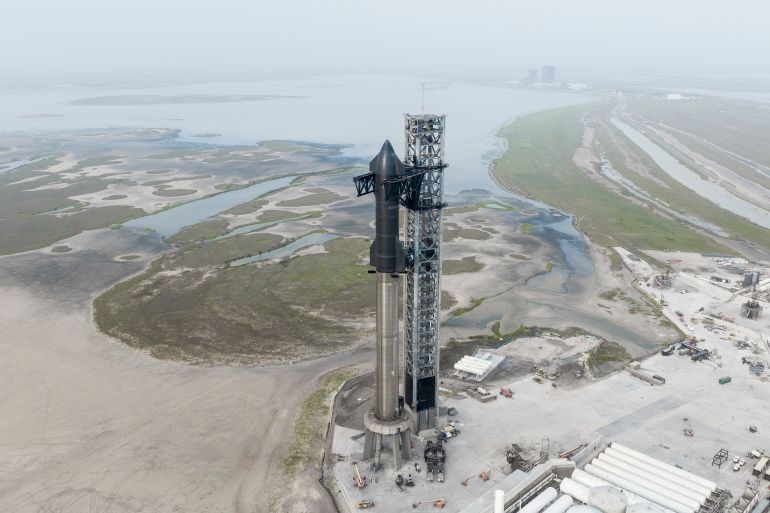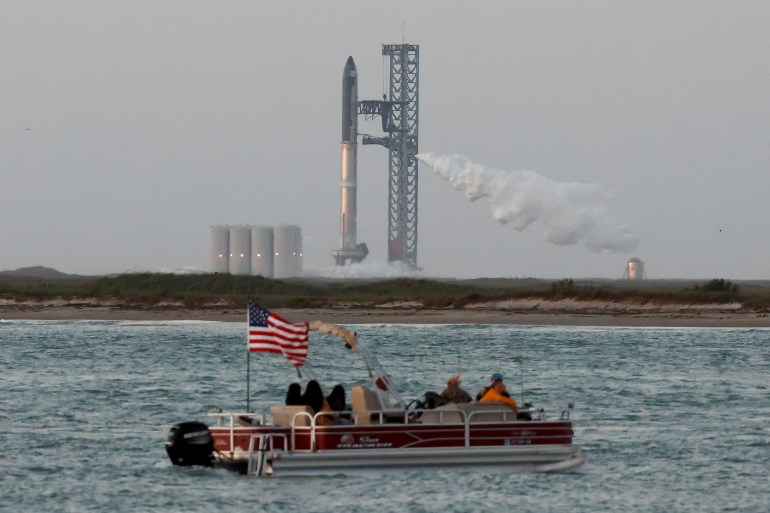SpaceX scrubs first test launch of behemoth Starship
SpaceX says the vessel, which would be the most powerful space rocket ever launched, will be key to one day reaching Mars.

SpaceX has scrubbed a highly anticipated test flight of its behemoth Starship, hours after the company’s billionaire founder Elon Musk sought to lower expectations surrounding the launch.
The California-based company announced in a live webcast during the final minutes of the countdown on Monday that it was cancelling the test for at least 48 hours. It cited a pressurization issue in the lower-stage rocket booster, known as the Super Heavy booster.
Keep reading
list of 3 itemsMusk, other tech experts urge halt to further AI developments
Musk says owning Twitter ‘has not been some sort of a party’
The cancellation left the spacecraft sitting on the launch pad in Boca Chica, Texas, the US, its stainless steel body stretching into the sky. The overall launch vessel is 120 metres (394 feet) tall, higher than New York City’s Statue of Liberty.
“Learned a lot today, now offloading propellant, retrying in a few days,” Musk tweeted after the launch was scrubbed.
A successful launch into space would represent a key milestone in SpaceX’s ambition of sending humans back to the moon and ultimately to Mars.
The United States space agency NASA has picked the Starship spacecraft to ferry astronauts to the moon in late 2025 – a mission known as Artemis III – for the first time since the Apollo programme ended in 1972.
The upper-stage Starship cruise vessel is designed to carry crew and cargo. It sits atop a 70-metre (230-foot) tall first-stage Super Heavy booster rocket. Both are designed to be reusable components with the ability to make a “soft” landing back on Earth, although neither part is expected to be recovered in the first test launch.
SpaceX opted to use stainless steel in Starship’s construction, as opposed to lighter alloys typically used in spacecraft. The material has substantially better temperature tolerance, but adds considerable weight.
Nevertheless, a successful debut flight would instantly rank the Starship system as the most powerful launch vehicle on Earth. As designed, the Starship rocket is nearly two times more powerful than NASA’s own Space Launch System (SLS), which made its debut uncrewed flight to orbit in November.

Prototypes of the Starship cruise vessel have made five subspace flights up to 10 km (6 miles) above Earth in recent years, but the Super Heavy booster has never left the ground. In February, SpaceX conducted a test-firing of the booster, igniting 31 of its 33 Raptor engines for roughly 10 seconds with the rocket bolted in place vertically atop a platform.
Monday’s launch was planned just three days after the Federal Aviation Administration granted a licence for the test, clearing a final regulatory hurdle for the long-awaited launch.
Still, Musk, speaking to a live event on Twitter Spaces on Sunday, said he wanted to “set expectations low” because “probably tomorrow will not be successful – if by successful one means reaching orbit”.
“It’s a very risky flight,” Musk said. “It’s the first launch of a very complicated, gigantic rocket”.
If a launch does go according to plan, all 33 Raptor engines will ignite simultaneously to loft the Starship on a flight that nearly completes a full orbit of the Earth before it re-enters the atmosphere and free-falls into the Pacific at supersonic speed about 60 miles (97 km) off the coast of the northern Hawaiian islands.
After separating from the Starship, the Super Heavy booster is expected to execute the beginnings of a controlled return flight before plunging into the Gulf of Mexico.